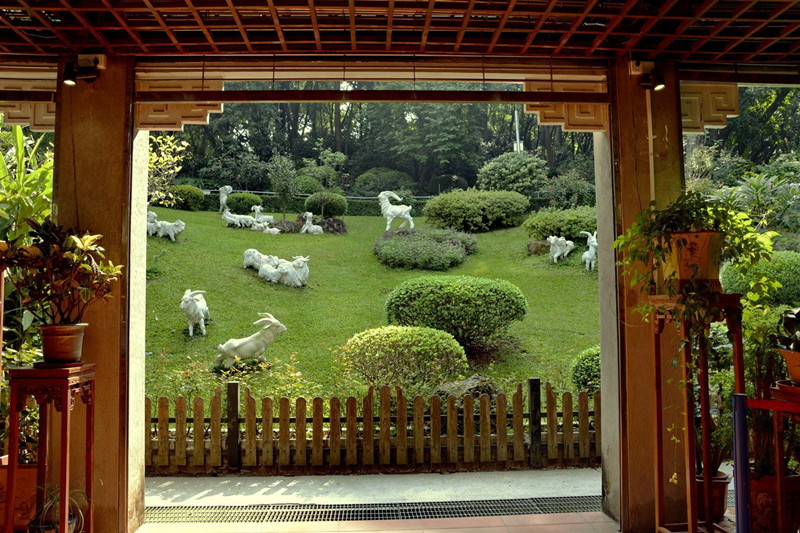
How to plan Guangzhou Tour?
Imagine a city where ancient temples stand beside futuristic skyscrapers, and the scent of sizzling street food fills the air. That’s Guangzhou – a “glittering metropolis” blending history and modernity. As the capital of Guangdong, Guangzhou is a bustling port on the Pearl River with a vibrant Cantonese heritage. Strolling through neighborhoods like Shamian Island(沙面岛) or Yuexiu Park(玉秀公园), you’ll see colonial-era buildings and lush hills; at the same time, towering landmarks like the Canton Tower soar into the sky. In short, Guangzhou offers a unique fusion of old as well as new China. Whether you’re here for dim sum, dragon dances, or simply soaking in a lively city vibe, planning ahead will help you make the most of your visit.
Best Time to Visit: Seasons & Weather
Guangzhou has a subtropical monsoon climate. Summers are long and hot, winters are short and mild. It rains heavily in the summer months, and winters are pleasantly cool (rarely freezing). Here’s what to expect each season:
-
Spring (March–May): Temperatures warm from about 15°C to nearly 29°C by May. This season can still be cloudy or drizzly, with the first thunderstorms arriving by mid-March. But spring brings blooming flowers and outdoor festivals, making it a lovely time to wander in parks or visit flower shows.
-
Summer (June–September): Guangzhou’s longest season is hot, humid and rainy. Daytime highs often reach 32–36°C, and downpours or typhoons can occur. If you visit in summer, plan lots of indoor breaks (AC cafes or temples) and carry an umbrella. Evening river cruises or air-conditioned malls can offer relief from the heat.
-
Autumn (October–November): The rains ease off and skies clear. Daytime temperatures become comfortable (around 20–25°C). It’s often the best weather of the year – warm days and cooler nights. Autumn also brings cultural events like Mid-Autumn Festival.
-
Winter (December–February): Winters are very mild – daytime highs around 19–21°C. It rarely drops below 10°C, though nights can feel chilly. The city is dry and mostly sunny by January. Winter is a great season for hiking up Baiyun Mountain or cruising the (cool) Pearl River. Chinese New Year (late Jan/Feb) can be festive, with markets and lanterns everywhere.
Generally, spring (March–May) and autumn (October–November) are ideal for sightseeing (mild and pleasant). Plan your trip around these seasons if possible, but Guangzhou’s inviting indoor attractions and festivals mean there’s fun any time of year.
Taste of Canton: Food Highlights
No visit to Guangzhou is complete without diving into its world-famous cuisine. In fact, travelers often call Guangzhou a “paradise for food lovers”. The city is the birthplace of Cantonese food traditions like yum cha (morning tea,早茶) and dim sum, so be sure to take a break for a steamed banquet of dumplings and buns. You might start your morning at a classic tea house (lots of locals do!), ordering har gow (shrimp dumplings蒸饺) or char siu bao (BBQ pork buns叉烧包) along with hot jasmine tea(菊花茶).

Later in the day, explore Guangzhou’s vibrant street food markets and snack stalls. Tuck into grilled skewers, rice noodle rolls (cheong fun肠粉), or a bowl of hot wonton noodle soup(云吞面). Sweet treats include creamy double-skin milk pudding(双皮奶) or mooncakes(月饼) if you’re there around mid-autumn. Key dining spots for independent travelers include the food stalls on Shangxiajiu Pedestrian Street, the night markets around Beijing Road, and the historic Beiyuan Snack Street (北园小吃街). You can also sample local specialties like roast goose, succulent braised pork belly, or even snake soup at famous eateries.
-
Must-try dishes: Dim sum (yum cha breakfast); roast goose or char siu (barbecue pork); claypot rice(煲仔饭); fresh seafood; Cantonese hot pot; sweet and sour pork; and tropical fruits (mango, lychee).
-
Where to eat: Try large traditional restaurants like the Guangzhou Restaurant or Tao Tao Ju for dim sum; or simply follow your nose at local food courts and snack streets. Many travelers say the best food is found off the beaten path – don’t hesitate to follow a crowd of locals to a busy eatery!
With its “rich culinary heritage,” eating is both a daily ritual and an adventure in Guangzhou. Every meal becomes a social occasion here – you’ll find locals laughing and chatting over steaming bowls. Whether you’re sipping tea in a century-old dim sum house or munching sugarcane juice on the street, the flavors of Guangzhou are sure to delight.
Cultural Highlights and Neighborhoods
Beyond food, Guangzhou offers a wealth of culture and history to explore. It’s often said Guangzhou has “a little bit of everything,” from ancient temples to modern art. Here are some cultural must-sees:
-
Temple of the Six Banyan Trees (Liurong Temple六榕寺): A beautiful Buddhist temple over 1,000 years old, known for its tall Flower Pagoda and serene gardens. Step inside to admire incense coils and painted halls, and see the statue of the Laughing Buddha in Tianwang Hall.
-
Chen Clan Ancestral Hall (Chen Clan Academy陈家祠): A 19th-century academy turned folk-art museum. The intricate wood, brick and stone carvings here are famous examples of Cantonese craftsmanship. (Insider tip: it’s now the Guangdong Folk Arts Museum – the courtyard architecture and carved roof decorations are stunning.)
-
Sun Yat-sen Memorial Hall(中山纪念堂): A grand domed auditorium built in honor of China’s founding father, Sun Yat-sen. The building (completed 1931) has Ming-style columns and a large bronze statue of Sun inside. On clear days you can climb the pavilion for a view over Yuexiu Park.
-
Shamian Island(沙面岛): Once a colonial concession area, this leafy island feels like a quiet European village. Its sandstone mansions, churches and tree-lined boulevards date back to when British and French traders settled here. It’s perfect for a relaxed afternoon stroll, and you’ll find cozy cafés and local markets in its tiny squares.
-
Modern Cultural Spots: Don’t miss the Guangdong Museum (designed like a jade comb) for art and history exhibits, and the striking Guangzhou Opera House by Zaha Hadid on the riverside. Both offer a glimpse into the city’s contemporary side.
Each of these experiences mixes history with living tradition. You might catch monks chanting at a temple, see students practicing Cantonese opera in Yuexiu, or browse crafts in a folk-art museum. By day, wander through old neighborhoods (try the Lingnan architecture in Liwan District) and art districts; by night, soak up the ambience at a traditional tea house or a lakeside park pavilion. With its blend of ancient and modern, Guangzhou is a cultural playground for curious travelers.
Must-See Attractions
Of course, no tour is complete without the big landmarks. Here are some Guangzhou icons to add to your itinerary:
-
Canton Tower(广州塔): The city’s ultra-modern TV tower (602 m tall) is a symbol of Guangzhou. You can ride elevators up to observation decks for panoramic city views and even dangle in the skywalk. The tower “slender waist” shape is famous and it lights up in colorful patterns after dark. It briefly held the title of world’s tallest tower when it opened in 2010.
-
Yuexiu Park(越秀公园): Guangzhou’s largest downtown park (860,000 sqm) combines lakes and hills with history. It’s famed for the Five-Ram Sculpture, an enormous statue that has become the city emblem. The park also contains the ancient Zhenhai Tower (now the Guangzhou Museum) and old city wall remains. Climbing the hill and strolling its gardens is a pleasant way to spend a morning.
-
Shamian Island(沙面岛): As mentioned above, Shamian is a peaceful walk through colonial-era Guangzhou. It’s especially lovely in the late afternoon sunlight, and you’ll see statues and cafes in its small park.
-
Pearl River Cruise(珠江夜游): Seeing Guangzhou from the water is a must. A night cruise on the Pearl River treats you to glittering skyline views (Canton Tower, Haixinsha Island, and other lit-up bridges). The rides typically depart from Zhujiang New Town or downtown by the Haixinsha/Ersha Island area.
-
Beijing Road and Shangxiajiu Pedestrian Streets: These two historic shopping streets are tourist favorites – full of shops, eateries, and a glimpse of old Guangzhou (you can even see ancient road pavers under glass in Beijing Road). Great for picking up souvenirs or sampling street snacks as you explore.
Each bullet above covers just one highlight. Of course, feel free to mix and match based on your interests – Guangzhou rewards both museum-goers and market browsers alike! The key is variety: combine sightseeing (towers, temples, parks) with everyday local life (street markets, tea houses) for a complete picture of the city.
Plan Your Trip with Us
Guangzhou is a friendly, welcoming city and easy to navigate. Metro and buses can take you anywhere, but a local guide or travel planner can save you time and share insider tips (like where to find the best morning dim sum or hidden alleys in old town).
If you’d like a customized itinerary or some personal advice, we’re here to help! Contact our travel experts for a free consultation. We’ll work with your interests and schedule to craft a Guangzhou tour just for you – whether it’s the perfect foodie adventure, a family-friendly city trip, or a deep cultural exploration. Give us a shout and soon you’ll be sipping tea at a Cantonese teahouse under the warm southern sky!



















